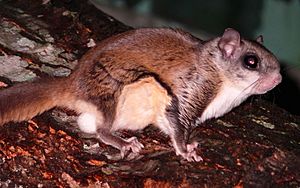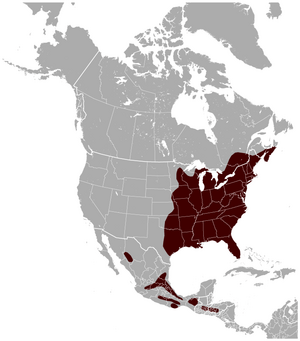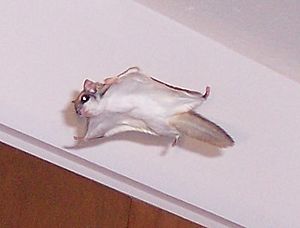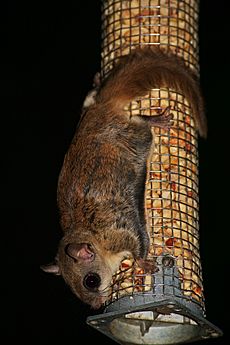Southern flying squirrel facts for kids
Quick facts for kids Southern flying squirrel |
|
|---|---|
 |
|
| Conservation status | |
| Scientific classification | |
| Genus: |
Glaucomys
|
| Species: |
volans
|
| Subspecies | |
|
|
 |
|
| Southern flying squirrel range | |
| Synonyms | |
|
Mus volans Linnaeus, 1758 |
|
The southern flying squirrel (Glaucomys volans), also called the assapan, is a small flying squirrel found in North America. It is one of three flying squirrel species living in this area. You can find it in forests across the eastern half of North America, from southeastern Canada all the way to Florida. Some groups of these squirrels also live in the highlands of Mexico, Guatemala, and Honduras.
Contents
What Does a Southern Flying Squirrel Look Like?
Southern flying squirrels have soft, grey-brown fur on their backs. Their sides are a bit darker, and their bellies are a creamy white color. They have big, dark eyes that help them see at night. Their tails are flat, which helps them steer when they glide.
These squirrels have a special furry skin flap called a patagium. This flap stretches between their front and back legs. They use it to glide from tree to tree, almost like a superhero cape! An adult squirrel is about 21 to 26 centimeters (8 to 10 inches) long, including its tail. Their tail alone can be 8 to 12 centimeters (3 to 5 inches) long.
Southern Flying Squirrel Behavior
Southern flying squirrels are busy at night. They are nocturnal, which means they are active after the sun goes down. During the day, they sleep in cozy nests or tree holes.
What Do Southern Flying Squirrels Eat?
These squirrels love to eat fruits and nuts from trees like oak, hickory, and beech. They are smart and store food, especially acorns, to eat during the cold winter months. But nuts aren't all they eat! They also enjoy insects, tree buds, mushrooms, and even bird eggs. Sometimes, they might eat baby birds or flowers too.
Who Are Their Predators?
Many animals hunt southern flying squirrels. Common predators include snakes, owls, hawks, and raccoons. Even pet cats can be a danger to them.
How Do Southern Flying Squirrels Reproduce?
Southern flying squirrels can have two groups of babies, called litters, each year. Each litter usually has 2 to 7 young squirrels. The mother squirrel carries her babies for about 40 days before they are born.
When baby squirrels are born, they don't have fur and can't do much on their own. Their ears open when they are 2 to 6 days old. Soft fur starts to grow by the time they are 7 days old. Their eyes open later, when they are about 24 to 30 days old. Mothers stop feeding their young milk when they are about 65 days old. The young squirrels become fully independent around 120 days of age.
How Southern Flying Squirrels Glide
Even though they are called "flying" squirrels, they don't actually fly like birds. Instead, they glide! They use their special skin flap, the patagium, to soar through the air.
To start a glide, a squirrel climbs to the top of a tree. They might take a running start or just jump from where they are. They pull their legs under their body and push off the tree. Before jumping, they often lean out and look around. This helps them figure out where they want to land.
Once in the air, they spread their arms and legs wide, forming an "X" shape. This stretches their patagium into a square-like shape. They glide downwards at a gentle angle. They are very good at steering in the air. They can even make sharp turns around trees if they need to!
Just before landing, they lift their flat tails. This helps them slow down and point upwards. They also point all their limbs forward. This creates a "parachute" effect with their patagium, which makes their landing softer. Their strong legs absorb the rest of the impact. As soon as they land, they quickly run to the other side of the tree trunk or climb higher. This helps them hide from any animals that might want to catch them. While they are amazing gliders, southern flying squirrels are not very good at walking on the ground. If they are on the ground and sense danger, they prefer to hide rather than try to run away.
Where Do Southern Flying Squirrels Live?
Southern flying squirrels make their homes in eastern deciduous forests or mixed forests across North America. They especially like areas with large hickory and beech trees. Maple, poplar, and oak trees also make good homes for them. You might find them in wooded areas near towns, but they usually don't live there in large numbers.
Southern Flying Squirrel Home Ranges
The area a southern flying squirrel uses for living and finding food is called its home range. The size of this area can be different for each squirrel. On average, male squirrels have larger home ranges than females. This might be because males need to travel further to find mates. Female squirrels' home ranges can get much bigger after their babies leave the nest.
Squirrels living in the northern parts of their range tend to have larger home ranges. This is because food trees are more spread out there. The same thing happens in forests that are broken up into smaller pieces. In these areas, nesting spots and food sources are far apart.
Where Do Southern Flying Squirrels Nest?
Southern flying squirrels build their nests in natural holes in trees or in old woodpecker holes. They also build nests out of leaves and twigs. Leaf nests are often used in the summer for resting. Tree cavities are used for raising babies and are especially important in winter.
The tree holes they use are often in small dead trees or large living trees. The entrance to their nests is usually small, about 4.7 centimeters (1.8 inches) wide and 9.4 centimeters (3.7 inches) high. These entrances are usually about 6.36 meters (20 feet) above the ground.
Squirrels often place their dens near the edge of their home range, away from open areas. When they need to cross open spaces, like areas where trees have been cut down, they prefer to use paths of older, mature trees. This shows they are sensitive to changes in their forest homes.
Southern Flying Squirrel Social Life
Southern flying squirrels are very social animals. You might see them flying and looking for food together in big groups. They also often gather together in dens, especially when it gets cold. This helps them save energy and stay warm. Squirrels that nest together in winter can save 30 percent more energy than those that nest alone.
Even though they prefer to nest with family members, they are okay with other squirrels they know. This might be because other squirrels help keep the group warm. It also helps with outbreeding, which means mixing genes with squirrels from other families.
Some studies suggest that nesting together might not be good when it's warm. However, even in warmer places like Florida, southern flying squirrels nest in large groups. Sometimes, up to 25 squirrels can be found in one nest! This suggests that nesting together is important for more than just staying warm. It might also help with their social organization. Being in a group could help them find mates, protect themselves from predators, or find more food.
Scientists have also found that squirrels nesting together are often related. This could be a form of kin selection. This means that an individual's stored food might help their relatives survive if something happens to them.
Scientists have studied how squirrels find hidden food. They found that when nuts are dry, squirrels mostly use their memory to find them. But when the environment is wet, smell becomes important for finding food.
See also
 In Spanish: Ardilla voladora del Sur para niños
In Spanish: Ardilla voladora del Sur para niños




